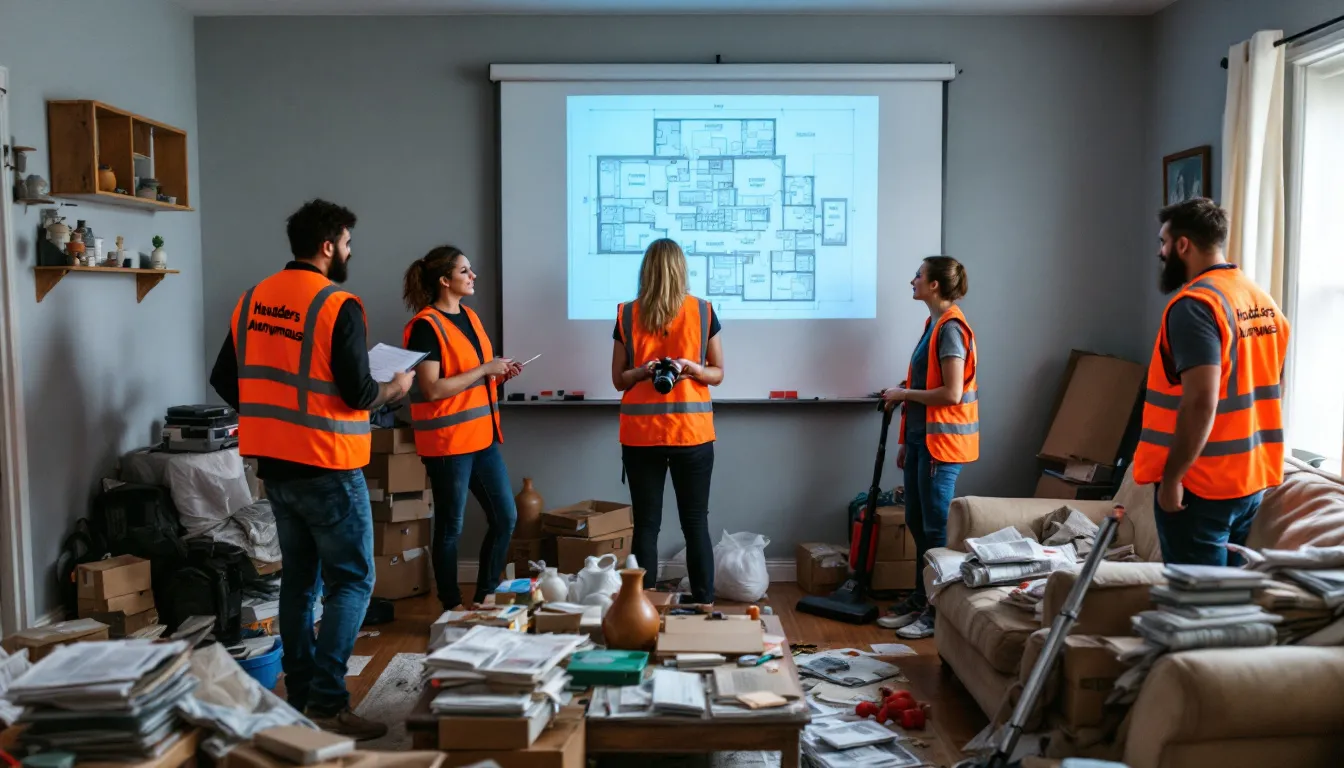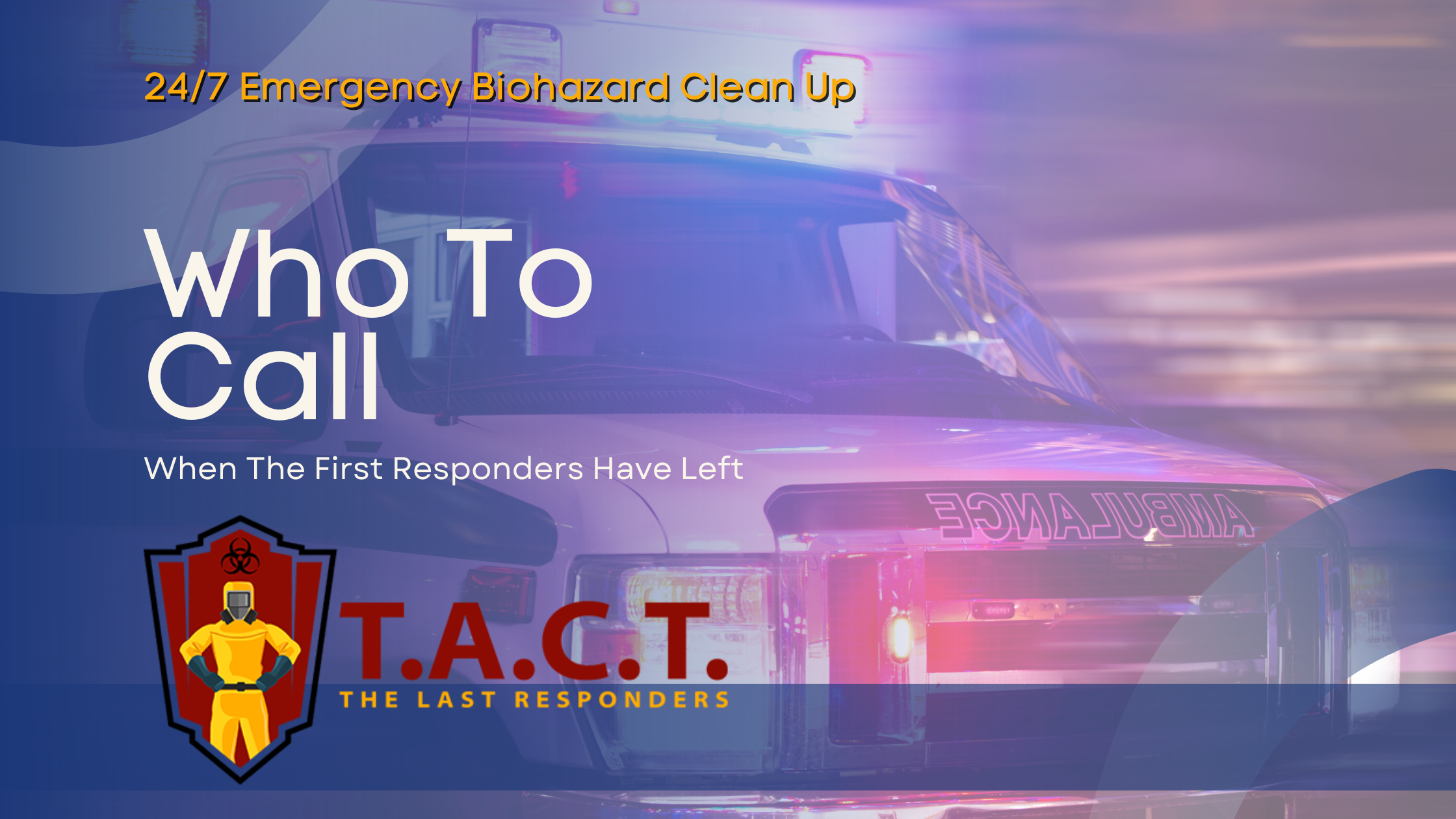stress Free hoarding cleanout

Effective Tips for Stress-Free Hoarding Cleanouts
Dealing with a hoarder’s home can be complicated and overwhelming. In this guide, we’ll cover practical tips, safety measures, and emotional support strategies for effective hoarding cleanouts.
Key Takeaways
Hoarding disorder is a complex mental illness that requires a compassionate approach to cleanouts, addressing both emotional attachment and safety risks.
Effective preparation for cleanouts involves assessing the property, gathering necessary supplies, and creating a structured plan with manageable steps.
Engaging professionals with decades of experience and establishing open communication with the hoarder can facilitate a smoother cleanout process while promoting emotional support and safety.
Introduction to Hoarding
Hoarding is a complex issue that affects millions of people worldwide, causing significant health and safety issues in hoarding situations. Unlike simple clutter, hoarding involves the persistent difficulty in discarding or parting with possessions, regardless of their actual value. This behavior can lead to dangerous living conditions, including fire hazards, mold growth, and infestations, which pose serious health risks.
Hoarding cleanup is a delicate process that requires compassion, understanding, and expertise to address the underlying issues of hoarding disorder. It’s not just about removing clutter; it’s about recognizing the emotional attachment and sentimental value that individuals place on their belongings. This emotional connection can make the cleanup process particularly challenging, requiring a sensitive and respectful approach.
Professional hoarding cleanup services involve safely removing clutter, junk, and hoarded items from a hoarder’s house, including storage units and household goods. These services are equipped to handle the complexities of hoarding situations, ensuring that the cleanup is conducted safely and efficiently. The cost of hoarding cleanup can vary depending on several factors, including the scope of the project, the amount of debris, and the level of expertise required.
Hoarding cleanup is not just a matter of removing trash; it also involves dealing with the emotional and psychological aspects of hoarding disorder. Professional services can help individuals and families affected by hoarding to restore their homes and lives, promoting a sense of peace and well-being. With the right approach and expertise, it is possible to safely remove clutter and hoarded items, creating a clean and organized space.
Hoarding cleanup requires a comprehensive approach that involves cleaning, organizing, and disposing of unwanted items, as well as providing support and resources for individuals struggling with hoarding disorder. By addressing both the physical and emotional aspects of hoarding, professional cleanup services can help individuals reclaim their living spaces and improve their quality of life.
Understanding Hoarding and Its Challenges

Hoarding disorder goes beyond a simple habit of collecting things. It is a significant psychological condition that manifests as an inability to part with items, regardless of their actual worth. This tendency can be traced back to factors like tumultuous childhoods or the death of close family members, causing those affected to seek solace in their belongings. A deeper understanding of these motivations behind hoarding is essential for more compassionate and efficient house cleanouts.
The bond that individuals with hoarding tendencies form with their possessions adds complexity during the cleanup process. Often believing they might require these items later on or attributing excessive sentimental value to them makes discarding objects incredibly challenging. The sheer weight of this emotional connection may lead to overwhelming feelings, sparking anxiety and indecision when faced with decluttering tasks. Engaging with the person involved is crucial, as personalized communication and support can improve cooperation and respect the psychological sensitivities to avoid exacerbating the situation.
The persistent accumulation characteristic of hoarders disrupts everyday life while also creating substantial health risks due primarily to clutter-induced dangers such as fire hazards and pest infestations—detrimentally impacting one’s standard living conditions. Hoarders frequently struggle alongside mental illnesses including OCD (obsessive-compulsive disorder), ADHD (attention deficit/hyperactivity disorder), and depression, which tend commonly accompany7 this type disordered behavior. Complicating cleaning processes necessitate empathetic strategic planning specifically tailored towards addressing unique challenges associated with house clear outs amongst people exhibiting severe accumulative behaviors.
A common issue among those who hoard is not recognizing their actions as detrimental, which poses additional obstacles regarding engaging treatment intervention methods successfully implementing necessary removal unwanted materials. It isn’t merely about eliminating excess stuff, it is holistically confronting foundational concerns whilst delivering supportive measures aimed at ensuring future preventative relapse scenarios.
Preparing for a Hoarding Cleanout

Initiating the cleanup process for a hoarding situation involves conducting an initial assessment of the premises. Providing images of the property can help clarify how extensive the cleanout will need to be. It is vital to evaluate any concerns regarding health and structural integrity before beginning, which includes looking into what types of items have accumulated and identifying possible hazards such as shattered glass, vermin, or mold presence.
Ensuring that you have all required supplies on hand is critical for facilitating a smooth cleanout operation. This should include robust garbage bags, cleaning agents, boxes for sorting items, along with protective equipment like goggles, gloves, and face masks. Assessing both manpower needs and time allocation aids in devising an effective strategy for managing the cleaning venture methodically. Should hazardous substances be found during this endeavor, it’s imperative to engage professional services equipped to deal with them safely.
To avoid being swamped by the magnitude of a cleanout task, due diligence in planning must not be overlooked. Divvying up activities into smaller segments while taking every necessary safety measure promotes greater efficiency alongside reduced stress levels throughout this intensive cleanup journey—meticulous preparation holds paramount importance when tackling successful house clearing from excessive accumulation situations known as hoarding. Contact professionals for assistance with the cleanup process to ensure a safe and effective restoration of your living space.
Communication and Emotional Support During Hoarding Cleanouts
Creating a strong personal bond and ensuring continuous dialogue with the hoarder is vital for an effective cleanout. During this process, it’s important to exercise patience, show empathy, and acknowledge their emotions. Steer clear of any comments that may come off as ridicule or disrespectful in order to foster a constructive and collaborative environment. Such an approach not only builds trust but also ensures that the individual feels respected and backed by others, enhancing communication.
Bring the hoarder into the heart of planning can have a profoundly positive effect on the outcome. Allowing them control over what happens with their possessions typically leads to better cooperation and decision-making from them. Commemorating even small triumphs during cleanup activities can boost motivation and underline forward movement throughout this journey. Taking intermittent breaks amid cleaning efforts is critical in addressing emotional strain while keeping vitality up—key components among several factors driving successful cleanouts.
Securing professional assistance has its merits in safeguarding familial bonds by smoothing out difficult discussions among loved ones involved. These specialists offer neutral insight and play a role as peacemakers when tensions run high due to emotive encounters occurring through this endeavor. By setting achievable expectations upfront—and recognizing that stumbling blocks are part of the journey—the stress levels for both parties: hoarders themselves as well as those aiding them could diminish significantly—a testament to how impactful supportive professionals are within these situations. By embracing kindness coupled with unwavering support towards those entangled within such challenging circumstances, including any family member, elevates what might appear overwhelming into potentially life-altering experiences beneficial for everyone participating.
Breaking Down the Cleanup Process

Initiating the hoarding cleanup by focusing on areas that are less intimidating can render the whole project more feasible. Tackling one room at a time not only prevents stress, but also fosters an environment of achievement as you move through each space. By categorizing hoarded items into distinct groups, such as those to retain, sell off, or give away, it simplifies and streamlines the organization and efficiency of the cleaning process.
By setting attainable goals and establishing daily routines for sorting items and cleaning-up activities, this approach lays out a consistent schedule that wards off exhaustion from setting in. Once free from clutter, deep cleaning is critical to revive spaces back to their habitable state. Taking moments to acknowledge each milestone achieved can be uplifting throughout your journey by keeping spirits elevated amidst what may seem like an extensive endeavor.
Demystifying what might appear like an insurmountable task into incremental steps with clear objectives enhances its attainability while simultaneously minimizing anxiety levels during execution — all beginning with modest initial efforts. This methodical strategy assures not just completion, but also aids in preserving enthusiasm throughout the job without letting pressure build up too much.
Junk Removal Strategies
Effective junk removal strategies are essential for successful hoarder cleanouts, involving a thorough assessment of the site and a well-planned cleanup process. The first step is to evaluate the extent of the hoarding situation, identifying the types of items accumulated and any potential health and safety hazards. This assessment helps in creating a structured plan for the cleanup process.
Hoarding cleanup services may involve donating, recycling, or disposing of items, depending on their condition and sentimental value. Items that are still in good condition can be donated to local charities, while recyclable materials can be sent to appropriate facilities. This approach not only reduces waste but also supports the community.
Professional junk removal teams use specialized equipment and techniques to safely remove debris and hoarded items, minimizing the risk of injury or damage. They are trained to handle hazardous materials, such as mold or sharp objects, ensuring that the cleanup is conducted safely. This expertise is crucial in managing the complexities of hoarding situations.
Hoarding cleanup requires a flexible and adaptable approach, as each situation is unique and may involve complex emotional and psychological factors. A key factor in successful hoarder cleanouts is the ability to work with family members and loved ones, providing support and guidance throughout the cleanup process. This collaborative approach helps in addressing the emotional challenges associated with hoarding.
Hoarding cleanup services may involve multiple visits and a long-term commitment to maintaining a clean and organized space, requiring ongoing support and motivation. The cost of junk removal can vary depending on the type and amount of debris, as well as the level of expertise required. Therefore, it is essential to work with a professional and reputable service to ensure a successful cleanup.
Hoarding cleanup is not just about removing junk; it also involves creating a safe and healthy environment, free from mold, rodents, and other health hazards. By employing effective junk removal strategies, professional services can help individuals and families affected by hoarding to reclaim their living spaces and improve their quality of life.
Safety First: Managing Health and Safety Issues
In situations where hoarding is present, the overaccumulation of items can result in dangerous living conditions, which may include heightened fire risks and other health-related hazards. Emphasizing these safety issues during initial discussions underscores the value of undergoing a cleanout process. A thorough evaluation for potential dangers such as infestations from rodents or the presence of mold should precede any cleanup efforts to ensure that such risks are effectively managed through hoarder cleanouts.
Using appropriate personal protective equipment (PPE) is vital in safeguarding against various health and safety concerns that might arise during a cleanout. The use of disposable masks assists in protecting from airborne pollutants, while gloves designed to resist punctures are essential for handling sharp objects safely. Goggles become necessary when encountering dusty scenarios or chemicals, offering eye protection. Similarly, steel-toed boots provide foot defense against heavy or sharp debris amidst clutter. For overall safety from bacteria and viruses potentially found within hoarded material, wearing disposable coveralls can be beneficial throughout the cleaning procedures. Additionally, it is crucial to properly dispose of hazardous materials to prevent further contamination and ensure a safe environment.
Having an experienced team proficiently trained for these circumstances proves indispensable when navigating the various hazards inherent to environments affected by hoarding behavior. Their specialized knowledge plays a critical role in conducting safe and effective cleanup operations while lessening potential threats to all individuals involved with completing successful stress-minimized hoarder cleanouts—where ensuring adherence to proper safety protocols remains paramount.
Professional Help for Hoarding Cleanouts

Enlisting professional help for hoarding cleanouts can significantly ease the emotional and practical difficulties involved. Teams of professionals equipped with both training in efficiency and an empathetic approach, expertly navigate the intricacies inherent to such situations. They offer reassurance while providing vital support throughout each step of the cleaning process. Hiring specialists for hoarding clean services is often the safest and most effective solution, as they handle the situation with sensitivity and a commitment to responsible disposal, including recycling and donating items.
Through precise planning and tailored approaches, these specialists come prepared with advanced tools and equipment designed to optimize cleanup effectiveness. A key benefit they provide is their ability to manage waste removal proficiently, ensuring that rubbish is disposed of responsibly while returning the area back into a habitable state.
Professionals are also adept at mitigating any psychological barriers encountered during cleanup efforts by drawing on skills obtained from specialized training in counseling. Their profound knowledge paired with appropriate instruments simplifies what might otherwise be perceived as an overwhelming task — converting it into a systematic endeavor marked by structure and reduced stress levels for everyone involved.
Deep Cleaning and Organization
Deep cleaning and organization are critical components of the hoarding cleanup process, involving a thorough and meticulous approach to cleaning and sanitizing the space. Professional hoarding cleanup services use specialized equipment and techniques to remove dirt, grime, and other substances, creating a clean and hygienic environment. This deep cleaning is essential for restoring the home to a livable condition.
Organization is a key aspect of hoarding cleanup, involving the use of storage solutions, labeling, and categorization to create a functional and efficient space. By organizing items into categories and using storage solutions, it becomes easier to maintain a clutter-free environment. This organization helps in creating a sense of order and control, which is crucial for individuals struggling with hoarding disorder.
Hoarding cleanup services may involve working with clients to develop strategies for maintaining a clean and organized space, including regular cleaning schedules and organizational systems. These strategies help in preventing the re-accumulation of clutter and promote long-term maintenance of the space. The goal is to create a space that is not only clean and tidy but also functional and comfortable, promoting a sense of peace and well-being.
Hoarding cleanup requires a compassionate and understanding approach, recognizing that each individual’s situation is unique and may involve complex emotional and psychological factors. Professional hoarding cleanup services can help individuals and families affected by hoarding to develop the skills and strategies needed to maintain a clean and organized space, reducing stress and anxiety.
Deep cleaning and organization are ongoing processes that require commitment and motivation, but with the right support and resources, it is possible to create a clean, organized, and peaceful living environment. By addressing both the physical and emotional aspects of hoarding, professional cleanup services can help individuals reclaim their living spaces and improve their quality of life.
Disposal and Donation of Hoarded Items
During the process of cleaning out hoarded items, it is essential to emphasize recycling, donating, and discarding in order to diminish waste. Companies like TurboHaul make a point to direct as many items as possible towards local charities or recycling initiatives when performing junk removal tasks. By prioritizing these sustainable practices, they not only curtail unnecessary waste, but also provide aid to their community.
When handling the disposal and donation of accumulated possessions during cleanouts for hoarding situations, there are significant advantages for both individuals and the broader society. Reducing environmental harm becomes feasible through careful sorting of materials, which can then be repurposed—like art supplies delivered to schools or books given away to libraries—that may otherwise be discarded into landfills. Donating usable items to local charities helps minimize waste and promotes recycling alongside improving living environments.
The strategy employed by TurboHaul in disposing of and donating such articles underscores the value brought about by recycling efforts combined with societal contributions. This mindful treatment serves dual purposes: clearing up cluttered areas effectively while having a positive influence on social welfare. It motivates people who have an abundance of belongings to rid themselves thoughtfully of those that are no longer needed. TurboHaul's nationwide reach ensures that their professional hoarding cleanup services are accessible across the country, assisting clients in various locations.
Long-Term Strategies for Maintaining a Clutter-Free Space

To ensure a space remains free of clutter, long-term tactics are essential. Adhering to the ‘One In, One Out’ rule helps manage the accumulation of new items by requiring that an existing item is discarded with each addition. The key to sustaining tidiness over time lies in avoiding the urge to accumulate again after initial decluttering efforts.
When it comes to parting with belongings during donation processes, identifying appropriate recipients is imperative. Contributing these items can greatly aid entities like schools, libraries, and community groups while simultaneously keeping them out of waste facilities. Platforms such as Nextdoor provide convenient avenues for passing on possessions locally and should be used responsibly and with respect so donations reach those who truly stand to gain from them without adding unnecessary waste.
Employing strategies such as recycling or repurposing goods not only mitigates environmental harm but also promotes material longevity. Embracing orderly habits contributes positively to mental tranquility and optimizes living spaces for greater efficiency. Implementing these enduring approaches ensures the results from hoarding cleanouts persist, leading to an environment that’s both well-organized and free from excess clutter.
Summary
Addressing a hoarding cleanup necessitates an extensive, empathetic strategy. It’s essential to recognize the deep-seated emotional causes of hoarding and to prepare adequately for the task ahead. Offering emotional support, methodically segmenting the cleanup process, emphasizing safety, and enlisting professional assistance are all pivotal components. Clearing a hoarder's house requires professional support to manage the emotional and mental challenges involved, ensuring both compassion and experience are applied to handle the sensitive nature and physical dangers present. Properly discarding or donating accumulated possessions while establishing enduring habits for keeping an organized space contributes to a seamless and soothing cleanout experience.
It’s important to acknowledge that achieving a clutter-free environment is about more than just physical decluttering. It represents restoring tranquility, security, and functionality in living spaces. By adhering to these guidelines and approaches throughout your endeavor, you’ll be able to convert what seems like an overwhelming chore into something achievable—and potentially satisfying—taking careful steps one at a time and rejoicing over every small triumph on this journey.
Frequently Asked Questions
What is the first step in a hoarding cleanout?
The first step in a hoarding cleanout is to assess the property, focusing on health and structural safety concerns, often by taking photographs for evaluation.
How can I provide emotional support during a hoarding cleanout?
To provide effective emotional support during a hoarding cleanout, build a personal connection, maintain open communication, and involve the individual in the planning process.
This approach fosters trust and helps alleviate feelings of overwhelm.
Why is professional help recommended for hoarding cleanouts?
Professional help for hoarding cleanouts is recommended because they offer expertise, specialized tools, and emotional support, ensuring a more effective and less stressful experience.
What are some long-term strategies for maintaining a clutter-free space?
To maintain a clutter-free space long-term, adopt the ‘One In, One Out’ principle to prevent accumulation of items and ensure you have designated places for donations.
This proactive approach will help you sustainably manage your belongings.
How should hoarded items be disposed of or donated responsibly?
When getting rid of items you’ve accumulated, aim to recycle and give them away to neighborhood charities, educational institutions, or libraries. This approach helps cut down on waste and simultaneously provides support within your community.
Latest news

Bio Cleaning Services
Read More
Nosy neighbors peeking? T.A.C.T. North Atlanta offers discreet biohazard remediation for rodent infestations, mold, hoarding, and more. Unmarked vehicles, quiet experts, full privacy—24/7 service at 470-781-4775.
Read More
